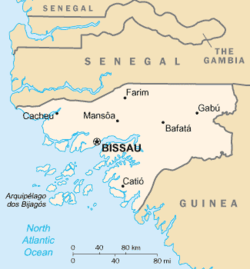Bissagos Islands
The Bissagos Islands, also spelled Bijagós (Portuguese: Arquipélago dos Bijagós), are a group of about 88 islands and islets located in the Atlantic Ocean off the coast of the African nation of Guinea-Bissau. The archipelago was formed from the ancient delta of the Rio Geba and the Rio Grande and spans an area of 12,958 km2 (5,003 sq mi).
| Designations | |
|---|---|
| Official name | Archipel Bolama-Bijagós |
| Designated | 14 January 2014 |
| Reference no. | 2198[1] |

Only some 20 islands are populated year-round, namely Bubaque which is where the Bissagos administrative capital is situated and is the most populated island, Bolama, Carache, Caravela, Enu, Formosa, Galinhas, João Vieira, Maio, Meneque, Orango, Orangozinho, Ponta, Roxa, Rubanhe, Soga, Unhacomo, Uno, and Uracane.
There is a high diversity of ecosystems: mangroves with intertidal zones, palm forests, dry and semi-dry forests, secondary and degraded forests, coastal savanna, sand banks and aquatic zones. The archipelago was declared in 1996 a UNESCO Biosphere Reserve—Bolama Bissagos Biosphere Reserve, known for animals including marine turtles, hippopotamus and the southern islands are today a nature reserve.
Demographics
The population is estimated at about 30,000 (2006) and the local ethnic group known as Bissago (Portuguese: Bijagó) predominates. It is a relatively youthful population due to high birth rates and low life expectancy even by African standards.
Economy
The economy is largely rural, with many families living from subsistence farming and fishing. There is some tourist activity, mostly boat charters from neighboring Senegal. Lack of infrastructure and communication links prevent the development of the islands' unique tourism potential.
Starting in the early 2000s, several the Bissagos islands began to be used as transit depots for narcotraffic,[2] which is quickly changing the social and economic fabrics of the islands.
The London School of Hygiene and Tropical Medicine is conducting research into infectious diseases on the islands. Because they are so isolated there is less danger of contamination of the results than in other places. [3]
The Bissagos Islands are considered one of the best places in the world to catch Atlantic tarpon.[4]
History
In pre-European colonial times, the islands were central to the trade along the coast of West Africa and they built up a powerful navy. In 1535, this enabled them to rout the Portuguese, who later built a fort on Bissao, which was abandoned in 1703.[5] The islands were not formally annexed by Portugal until 1936.[6][7]
The Bissagos were visited by Austrian anthropologist and photographer Hugo Bernatzik in 1930–1931, who documented daily life among the Bidyogo people.[8]
Culture
Due to difficulties of communication with mainland Guinea-Bissau that persist to this day, the population has a considerable degree of autonomy and has shielded its ancestral culture from outside influence. Mostly Bidyogo (Bijago in Portuguese) is still spoken along with Portuguese and creole. Bijago culture tends to be matriarchal, with women managing the household, the economy, law, as well as initiating courtship.[9]
Bissagos society is Animistic and characted by age-grade progression for both men and women (separately). The grade-ascension ceremonies (generally known as "fanados") take place years apart and entail extensive preparation and ceremony. The Bissagos have been erroneously considered to belong to matriarchal societies but closer examination has revealed a fundamentally patriarchal society where women, in spite of their substantial participation in material production and important roles in social, political, and religious matter, remain essentially unequal to men.[10] It is however true that it is the women who choose their husbands and terminate the matrimony; in Orango they make a single plate of food (often a traditional fish-eye platter) for the spouse-to-be, who agrees to the marriage by eating of the fish.
Art
The Bissagos peoples produce many artifacts for daily use and ritual following a traditional iconography that is unique to their culture, but shows variations from island to island. Among the most striking Bidyogo art pieces are the portable ancestor shrines ("iran") and the zoomorphic masks representing cows ("vaca-bruta"), sharks, stingrays and, occasionally, other local animals. Traditionally-decorated artifacts are also produced for "fanado" coming-of-age ceremonies (wood masks, spears, shields, headgear, bracelets), daily activities (fishing, agriculture) and personal use (stools, basketry, foodware). Its unique aesthetics make Bidyogo art easily distinctive from other African tribal arts.
Notable people
- Benkos Biohó, Former African king who was shipped to Cartagena, Colombia during the slave trade but managed to escape and found the maroon village known as San Basilio de Palenque.
See also
References
- "Archipel Bolama-Bijagós". Ramsar Sites Information Service. Retrieved 25 April 2018.
- Guiné-Bissau: Arquipélago dos Bijagós utilizado como depósito dos narcotraficantes – Governo, Agência Lusa, Visão magazine
- "Could these beautiful islands help stop killer diseases?". BBC. 14 November 2018. Retrieved 26 December 2018.
- Olander, Doug. "World's Best Tarpon Fishing Spots". sportfishingmag.com. Sport Fishing Magazine. Retrieved 21 June 2019.
- Edward Stallibrass, 'The Bijouga or Bissagos Islands, West Africa', in Proceedings of the Royal Geographical Society and Monthly Record of Geography, Vol. 11, No. 10 (Oct., 1889), p. 595.
- Thornton, John (1998). Africa and Africans in the Making of the Atlantic World, 1400–1800. Paris: Cambridge University Press. ISBN 9781139643382. Retrieved 2015-01-26.
- Henry, Christine (1994). Les îles où dansent les enfants défunts. Âge, sexe et pouvoir chez les Bijogo de Guinée-Bissau (in French). Paris: Les Editions de la MSH. pp. 66–68. ISBN 9782735116829. Retrieved 2015-01-26.
- Geheimnisvolle Inselntropen Afrikas: Frauenstaat und Mutterrecht der Bidyogo; ein Forschungsbericht 1933
- Guinea, Borders, and G. M. T. Time. "Guinea-Bissau." CABO 25.17 (2014): 17.
- Historical Dictionary of the Republic of Guinea-Bissau, 2013, page 51
Sources
- "Bijagós Islands." Encyclopædia Britannica
- An article about the land and the people of Bijagós Archipelago
- TVEDTEN, Inge The Difficult Transition from Subsistence to Commercial Fishing. The Case of the Bijagbs of Guinea-Bissau. Pages 129 to 130 In VAN GINKEL, Rob and VERRIPS, Jojada (editors) MAST (Maritime Anthropological Studies) Vol. 3, No. 1 1990 Krips Repro, Meppel, The Netherlands.